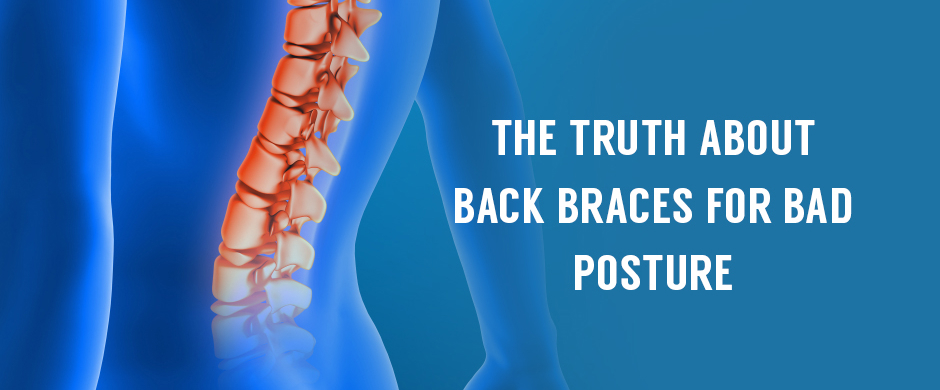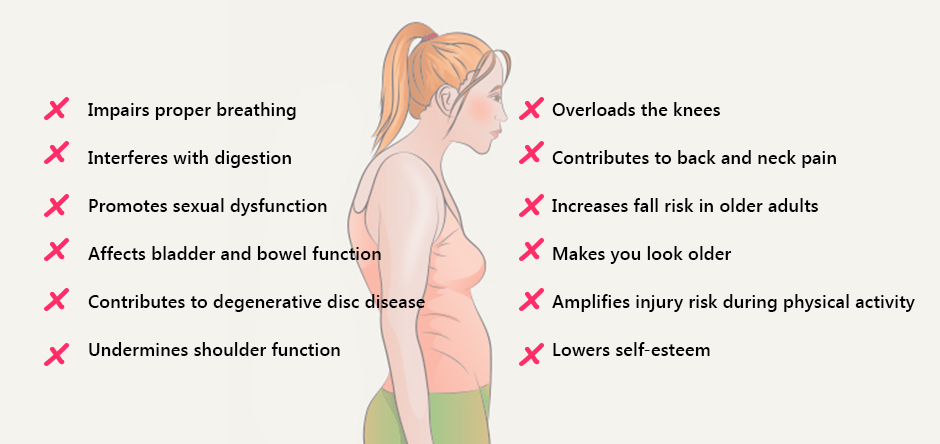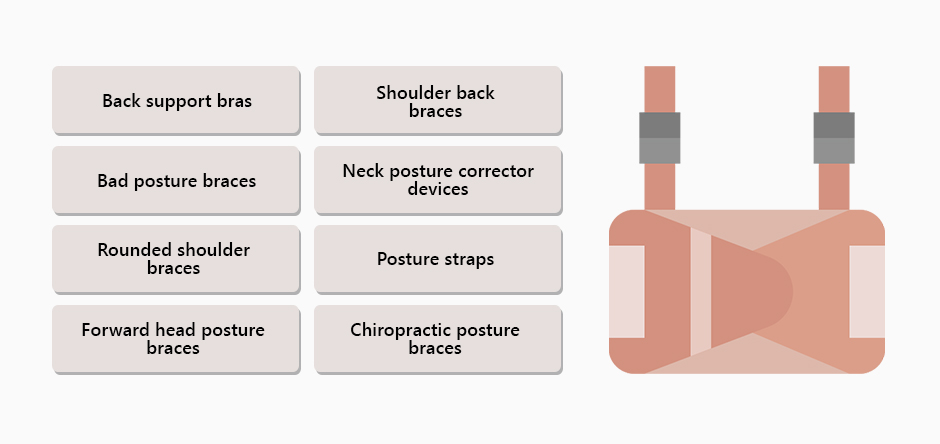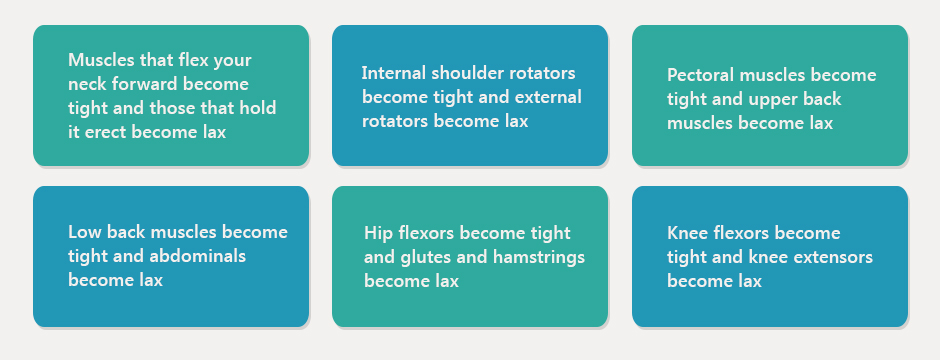
Posture describes how your body’s joints line up, relative to the force of gravity and to each other. When your joints are correctly aligned, your entire body moves more efficiently and exerts less effort. But the daily habits of modern living do not promote healthy posture.
Sedentary lifestyles with too much sitting and staring at screens have put people around the world at risk for back pain and other posture-related health issues that are far more widespread than ever before in human history.
In response to consumer demands, a plethora of back braces and corrective devices have emerged on the market to combat poor posture. But do back braces help posture, or are they just a passing fad?
From your toes to the top of your head, your joints and bones form an interdependent kinetic chain that is held in place by muscle tension. Postural deviations can originate anywhere along the kinetic chain, throwing the entire body out of alignment.
If you drop a plumb line down the side of your body from the center of your head to the floor, its path should trace the middle of your ear, shoulder and hip, fall just behind your kneecap, and trail slightly in front of your ankle bone. If your joints don’t align in this way, your posture needs a tune-up.

Forward head posture. Your head is as heavy as a bowling ball, weighing in at 10-12 pounds, teetering on just 7 cervical vertebrae and held in place by about 20 small muscles. If you spend a good portion of your day staring at your mobile device or hunched over a computer, your cervical spine may begin to curve forward, giving you forward head posture that can cause neck pain, headaches and TMJ syndrome.
Kyphosis. A close cousin to forward head posture, kyphosis creeps further down into your thoracic spine, causing your upper back to round and your shoulders to hunch forward. The weight of your head coupled with daily habits and behaviors exaggerate the kyphotic curve of your upper spine, making you look old, and interfering with proper breathing. Kyphosis can contribute to neck pain and degenerative disc disease. The condition is a marker of osteoporosis in older adults.
Lordosis, aka swayback. Lordosis is an overly pronounced curvature of the lumbar spine. It causes your hips and pelvis to tilt forward, compressing your lumbar vertebrae. Lordosis can be caused by excessive sitting, and is marked by weakened abdominal and core muscles, tight hip flexors, and weak glutes and hamstrings. Lordosis is a primary contributor to low back pain.
Flat back posture. This deviation occurs when your hips and pelvis tilt backward, flattening your natural lordotic curve. Flatback is common in people who stand all day, like school teachers or cashiers, especially if their core and abdominal muscles are weak. People with flat back posture often clench their buttocks when standing, settle their upper body weight on their pelvic bowl, and lock their knees, increasing their risk of knee pain.
Poor posture reduces your ability to move fluidly and efficiently, and it can make you look older than your years. It can reduce your ability to balance and stabilize your body while moving, and it projects an image of suboptimal health.

Poor posture can impact your health in multiple ways:
Impairs proper breathing
Interferes with digestion
Promotes sexual dysfunction
Affects bladder and bowel function
Contributes to degenerative disc disease
Undermines shoulder function
Overloads the knees
Contributes to back and neck pain
Increases fall risk in older adults
Makes you look older
Amplifies injury risk during physical activity
Lowers self-esteem
With modern living wreaking havoc on human posture, the demand for solutions is exploding. Recent lockdowns and remote work conditions have dramatically reduced physical activity and encouraged suboptimal posture.
In response to demand, a broad range of postural correction devices has emerged on the commercial market:
Back support bras
Bad posture braces
Rounded shoulder braces
Forward head posture braces
Shoulder back braces
Neck posture corrector devices
Posture straps
Chiropractic posture braces

With so many options available, we should all be sitting and standing straighter and taller. But sadly, there are three fundamental problems with posture braces:
While bad posture braces may not be harmful, they often fail to live up to their marketing hype. Ideally, your muscles and connective tissues should be sufficiently toned to hold your bones and joints in optimal alignment. When you wear any type of brace, you deprive your muscles of doing their job, causing them to become even weaker.
In addition, many posture issues are caused by tight muscles and connective tissues, and wearing a brace will not help with that. To achieve optimal postural alignment, you need to balance the muscle tension throughout your body. To do so, you need to strengthen weak and lax muscles, and stretch tight ones.
When you sit too much and don’t exercise on a regular basis, your posture deteriorates, and certain muscle pairs tend to become unbalanced:
Muscles that flex your neck forward become tight and those that hold it erect become lax
Internal shoulder rotators become tight and external rotators become lax
Pectoral muscles become tight and upper back muscles become lax
Low back muscles become tight and abdominals become lax
Hip flexors become tight and glutes and hamstrings become lax
Knee flexors become tight and knee extensors become lax

A well designed exercise program that includes walking, resistance training and stretching can help restore balance to the muscles that govern posture. As a bonus, you will look and feel younger, have more energy, and be less likely to acquire joint problems and incur injuries.
Wearing a brace and using posture correction devices can help boost your awareness of poor posture, but in the long run, improving your overall fitness will do more to correct your posture than any external apparatus. A chiropractor or physical therapy clinic can help you achieve optimal muscle balance, so you can fix your posture for good.
NYDNRehab is the premiere clinic for posture correction in NYC. The extensive expertise and experience of our clinicians, along with our battery of advanced technological tools, have put us ahead of the curve when it comes to helping our patients achieve optimal health and posture.
Don’t waste your money on braces and gadgets that fail to live up to their hype. Contact NYDNRehab today, and restore perfect posture so you can move through life with ease and confidence.
Dr. Lev Kalika is a world-recognized expert in musculoskeletal medicine. with 20+ years of clinical experience in diagnostic musculoskeletal ultrasonography, rehabilitative sports medicine and conservative orthopedics. In addition to operating his clinical practice in Manhattan, he regularly publishes peer-reviewed research on ultrasound-guided therapies and procedures. He serves as a peer reviewer for Springer Nature.
Dr. Kalika is an esteemed member of multiple professional organizations, including: